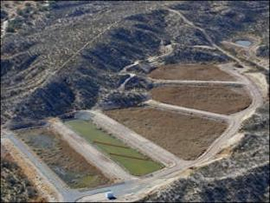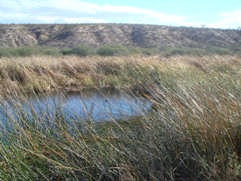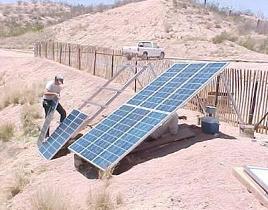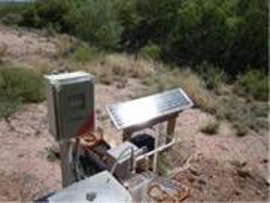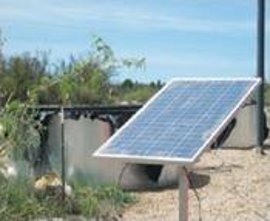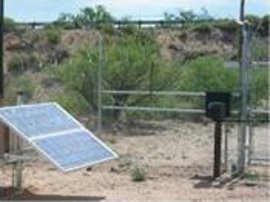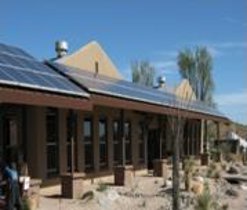Green Remediation Focus
Apache Nitrogen Products, Inc.
Benson, Arizona
Superfund NPL
Cleanup Objectives: Remediate soils and groundwater containing high concentrations of metals, nitrate-nitrogen, and explosives on 1,100 acres of a 9-mile2 property (formerly known as Apache Powder Company)
Green Remediation Strategy: Employ a hydraulically driven constructed wetland system, use native clay to cap contaminated soils, and capitalize on sources of onsite renewable energy to power cleanup equipment or offset grid electricity consumption
- Installed a 4.5-acre, tiered engineered wetlands to treat contaminated groundwater in the site's northern half; this remedial approach avoided typical chemical usage, energy consumption, and waste generation associated with a traditional alternative involving a wastewater treatment plant
- Capped ten contaminated evaporation ponds (in the site's southern half) with low-permeability covers made of native clay
- Used onsite solar and wind energy to power auxiliary equipment instead of extending power lines to the wetlands system, which is located in a remote portion of the property; initial equipment included: (1) a 1.4-kW photovoltaic (PV) system equipped with a solar-powered centrifugal pump to re-circulate water between the wetland ponds, and (2) a mechanical windmill to de-water a perched groundwater zone underlying the capped areas
- Maximized reinjection of wetlands-treated water directly into the alluvial aquifer rather than discharging all treated water to nearby surface water
Results:
- Reduced electricity costs for groundwater recirculation and de-watering by approximately 66% over the expected project life, when compared to the expense of installing new power lines and purchasing the electricity
- Operating the groundwater recirculation system only during daylight hours, which matches peak performance of contaminant degradation mechanisms occurring in the wetlands; sufficient PV-generated electricity is generated to re-circulate groundwater in the wetlands system (through 100 feet of 2-inch hosing elevated 10 feet from ground surface) at a rate of 5 gallons per minute
- Replaced the windmill after five years of operation with a small PV system, to accelerate de-watering of perched groundwater below the caps
- Expanded the use of onsite solar resources over recent years through small-scale PV applications that: (1) measure groundwater flow through the wetlands, and (2) operate lighting, motion detection, security camera, and gate control systems around the wetlands area
- Treated over 550 million gallons of groundwater (removing over 563,000 pounds of nitrates) between 1997 wetlands installation and early 2011, at a rate averaging 180 gallons per minute
- Continuing to achieve nitrate-nitrogen concentrations below the 10 µg/L drinking water standard, as compared to pre-remediation concentrations reaching 570 µg/L
- Directly recharging the underlying aquifer with the majority of treated water exiting the wetlands, with the remainder flowing a distance of less than one mile to the San Pedro River
- Providing a wetland habitat for wildlife such as deer, javelina, Gila monsters, bobcats, snakes, lizards, and amphibians, numerous bird species, and insect-consuming bats; wildlife-friendly fencing allows the animals access but denies entry by grazing livestock that can damage sensitive flora
- Installed a 42-kW solar canopy for the site's administrative buildings in late 2010, which is expected to annually save $6,400 in electricity costs and avoid a carbon dioxide (equivalent) emission of nearly 35,000 pounds each year; nearly 100% of the PV capital costs were covered by federal/state tax credits and utility incentives, with system payback expected in six years
- Recovering rainwater from the solar canopy for use in xeriscape landscaping in the site's desert environment; during heavy rain, a network of constructed rock-lined channels capture the runoff for gradual subsurface infiltration or release to the San Pedro River
- Considering future large-scale solar energy development on the capped ponds, if financially viable; a preliminary solar energy assessment suggests that a 2-MW system would meet the peak daily energy demand of the site's current chemical processing operations
Property End Use: Continued industrial operations
Point of Contact: Andria Benner, U.S. EPA Region 9
Update: July 2011


